by Todd Rutherford
One of the joys of gardening in Colorado is discovering beautiful North American native plants that thrive in our challenging growing conditions. A group of perennial flowers that are great for a low-water garden in our region are the Penstemons, also known as the Beardtongues.
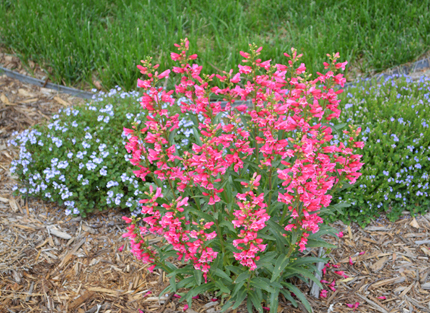
Coming from the Snapdragon family of flowering plants, penstemons provide a multitude of tubular flowers on their inflorescence that rise up above their various leaves. There are over 200 species of Penstemons. Their habits range from low growing ground cover types to taller ones that work in mixed border plantings or as showy specimen plants.
Although penstemons are usually short lived, around 3-4 years, many are easy to propagate from seed. Usually the life of the plants can be extended if you don’t overwater and if you dead-head the flowers after blooming.
Two species that I’ve grown from seed and that are quite striking in the garden are Penstemon barbatus, aka Scarlet Bugler Beardtongue, and Penstemon strictus, aka Rocky Mountain Penstemon. Penstemon barbatus has smaller gorgeous bright orange-red flowers, and Penstemon strictus has larger blue-purple colored flowers.
Definitely consider adding one of the beautiful and hardy penstemons to your water smart garden.
This is the official blog of Outdoor Design Group, Colorado Landscape Architects. For more information about our business and our services, click here.
Related Posts:
by Todd Rutherford
I recently wrote about growing your own antioxidant ‘superberries’ as part of a designed low-water landscape, and not just as part of the typical fruits and vegetable garden area. Another group of ornamental plants that fits this category and needs to be given more attention are the currants and gooseberries.
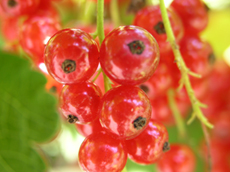
Red Lake Currant
These plants are small to medium shrubs that are mostly drought-tolerant and, for many of them, adaptable to sun or filtered shade. Best of all these shrubs provide healthy edible berries while providing landscape interest, with some even giving nice fall leaf color.
Red Lake Currant (Ribes rubrum) is possibly the best choice for Colorado gardeners who are looking for a mild-tasting red berry. It prefers full sun, but benefits from some afternoon shade in hot summer areas. It matures to 3-4’ high and 3-4’ wide.
If you’re more concerned with ornamental criteria, the native Golden Currant (Ribes aureum) will fit the bill with its yellow flowers and red fall leaf color. Golden Currant prefers partial shade and low to moderate water conditions, and produces red to black berries that are most delicious when left to dry on the shrub to a raisin-like fruit. Its common name comes from the beautiful yellow flowers and it has an open, rounded form, growing 4-6’ high and 4-6’ wide.
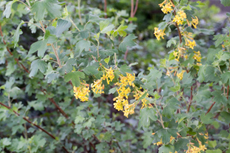
Ribes aureum – Golden Currant
Close cousins to the currants are the gooseberries. They are native to Eurasia, and grow as rambling shrubs with arching spiny branches. Gooseberry berries are larger than currants and sometimes have hairs on the skin. They are usually green colored, but some variants may range from red to deep purple. A recommended choice for Colorado is the Pixwell Gooseberry (Ribes uva-crispa ‘Pixwell’). Pixwell’s ½” size fruit are light green, becoming soft pink with maturity. The plant grows 3-4’ high and 3-4’ wide. Plant one of these in your yard so you can one day make a classic gooseberry pie!
Definitely consider making room in your landscape for a currant or gooseberry shrub. Many of them are well adapted to our dry Colorado climate, are moderately sized, provide ornamental interest and will reward you with antioxidant-rich berries to savor.
This is the official blog of Outdoor Design Group, Colorado Landscape Architects. For more information about our business and our services, click here.
Related Posts:
by Todd Rutherford
A recent trend in the food world has been the craze for antioxidants. Many tasty and healthy fruits and vegetables have been touted for their antioxidant components. Many of the best known antioxidant plants, such as green tea, coffee, cranberries and blueberries, are not easy or are impossible to grow in the Colorado landscape.
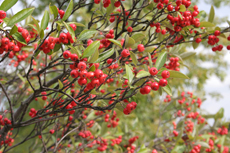
Aronia arbutifolia – Red Choke Berries
However one of the fruits highest in antioxidants can be easily grown in Colorado, providing spring flowers, edible berries, red fall color, and drought tolerance all in one package. Recent news reports have mentioned that Black Chokeberry (Aronia melanocarpa) shows one of the highest values of antioxidants ever recorded by researchers. In fact, scientists have placed its antioxidant powers above blueberries and cranberries.
While the chokeberry has twice as many antioxidants as blueberries, its taste is a challenge. As you may have guessed from the common name, the berries’ juice is astringent and not sweet. But juice from the berries can be made into wine, jam and syrup. The red chokeberry (Aronia arbutifolia) is slightly sweeter, and was used by Native Americans to make pemmican. But the red chokeberries probably don’t rank as high as the black ones on the antioxidant chart. The red chokeberry shrub does provide one of the best fall colors available, some saying it’s even better than the fall color of the burning bush.
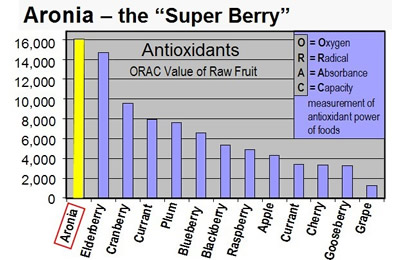 The two Black Chokeberry species that do well in Colorado are Aronia melanocarpa elata (height 5-8’ x spread 4-6’) and the dwarf Aronia melanocarpa Iroquois Beauty (height 48”-54” x spread 30-36”). These shrubs can tolerate periods of drought once established but prefer more moisture, and are adaptable to various light conditions, but do best is partial shade. Prefers neutral to acidic soil with higher organic content. They do have a suckering habit.
The two Black Chokeberry species that do well in Colorado are Aronia melanocarpa elata (height 5-8’ x spread 4-6’) and the dwarf Aronia melanocarpa Iroquois Beauty (height 48”-54” x spread 30-36”). These shrubs can tolerate periods of drought once established but prefer more moisture, and are adaptable to various light conditions, but do best is partial shade. Prefers neutral to acidic soil with higher organic content. They do have a suckering habit.
This is the official blog of Outdoor Design Group, Colorado Landscape Architects. For more information about our business and our services, click here.
Related Posts:
by Todd Rutherford
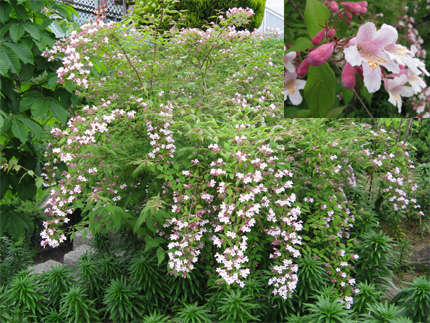
I recently discovered a flowering shrub that I thought was a new introduction, but has actually been a gardening staple for generations. I thought it might be a new shrub on the block because I’ve not encountered it in any public or private gardens in our region. Some sources state, however, that it was familiar to gardeners from previous generations. This shrub would be none other than Kolkwitzia amabilis, commonly referred to as the Beauty Bush.
As the common name would imply, Beauty Bush provides a stunning display of gorgeous bell-shaped pink flowers with yellow throats in late spring. The habit of Beauty Bush is vase shaped with sprawling, upright stems. It grows 10-15’ high and 12-15’ wide at maturity. This size would make it a good candidate for a large yard that needs a flowering shrub along the sides or back fence areas. Consider it as a choice for a large flowering hedge.
Best of all, this shrub is drought tolerant, though it can handle moderate watering, and prefers well drained soil. It can grow in full sun to filtered shade, but flowers best in full sun. Luckily for Colorado gardeners it tolerates clay soil and is adaptable to varied soil pH.
PLANT STATS
Scientific Name: Kolkwitzia amabilis
Plant Type: Deciduous Shrub
Mature Height: 10-15’
Mature Spread: 12-15’
Cold Hardiness Zone: 4 – 8.
Water Requirement: Medium, but has moderate drought tolerance. Give it an occasional deep soaking.
Exposure: Sun (will tolerate filtered shade)
Flower Color & Bloom Time: Pink. Spring.
Winter Interest: Exfoliating bark on mature stems.
Best Features: Profusion of small, pink, bell-shaped flowers in spring. Tolerates clay soil, grows in a wide range of soil conditions.
Disadvantages: Twiggy, wild look in winter may be undesirable for some.
Maintenance Tip: Prune out dead wood to reduce twiggy appearance. However keep in mind that it blooms from old wood.
Availability and Sizes: This plant seems to be regularly available. Various cultivars to choose from.
Wildlife Value: unknown
Have you used this shrub in your landscapes? If so, please comment on your experiences below.
This is the official blog of Outdoor Design Group, Colorado Landscape Architects. For more information about our business and our services, click here.
Related Posts:
by Todd Rutherford
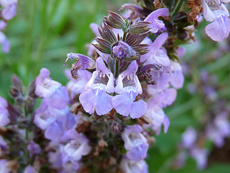
Culinary Sage
Many people may think that low-water gardening and edible plants are mutually exclusive. However, some of the tastiest culinary herbs are perennials that can find a home in your water-wise landscaping. So don’t just grow herbs in your vegetable garden, mix them into your perennial beds. While some of the culinary herbs need more water than extremely xeric plants, some of the best and most popular herbs are fairly drought tolerant, thriving in Colorado’s front-range climate.
Thyme is one commonly used herb that is fantastic when fresh. Even if you don’t intend to cook with fresh thyme, just picking a fresh sprig to crush in your hands, releasing the wonderful aroma, is reason enough to grow this versatile and hardy herb. Lemon thyme (Thymus citriodorus) is a great addition to cooked fish or chicken.
Lavender is one classic herb that loves Colorado’s growing conditions if you amend the soil to make it well-drained. Lavender is not commonly used in most American kitchens, but can be part of some amazing deserts and drinks. The best varieties for Colorado are Lavandula angustifolia ‘Hidcote’, Lavandula angustifolia ‘Munstead’ and Lavandula x intermedia ‘Provence.’
Oregano is perhaps one of the easiest herbs to grow in Colorado. In fact I’ve found that some varieties area so easily grown that they can become invasive due to their ability to re-seed. As with many herbs, some oregano varieties are better suited for cooking than others.
Culinary sage (Salvia officinalis) is more shrub like than the above listed herbs. As with the other herbs (most of which are in the Mint family) culinary sage produces gorgeous flowers that bees and other pollinators go crazy for. Culinary sage’s flowers are a gorgeous purple, blooming profusely in early summer. As with thyme, you may be familiar with its dried version, but fresh sage is much better.
A less drought tolerant group of herbs but that are still hardy and a nice addition to small pockets in flower beds are the chives. Regular chives and garlic chives are easy to grow and provide edible leaves and flowers. Toss in some fresh chive blossoms to your next breakfast egg dish, and you’ve turned an ordinary dish into something extraordinary.
This is the official blog of Outdoor Design Group, Colorado Landscape Architects. For more information about our business and our services, click here.
Related Posts:




 The two Black Chokeberry species that do well in Colorado are Aronia melanocarpa elata (height 5-8’ x spread 4-6’) and the dwarf Aronia melanocarpa Iroquois Beauty (height 48”-54” x spread 30-36”). These shrubs can tolerate periods of drought once established but prefer more moisture, and are adaptable to various light conditions, but do best is partial shade. Prefers neutral to acidic soil with higher organic content. They do have a suckering habit.
The two Black Chokeberry species that do well in Colorado are Aronia melanocarpa elata (height 5-8’ x spread 4-6’) and the dwarf Aronia melanocarpa Iroquois Beauty (height 48”-54” x spread 30-36”). These shrubs can tolerate periods of drought once established but prefer more moisture, and are adaptable to various light conditions, but do best is partial shade. Prefers neutral to acidic soil with higher organic content. They do have a suckering habit.
